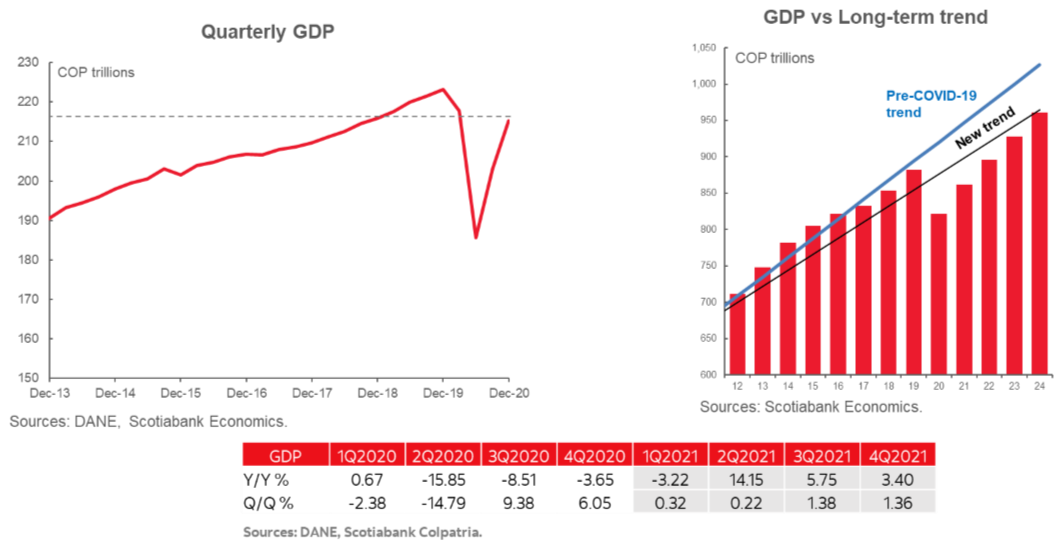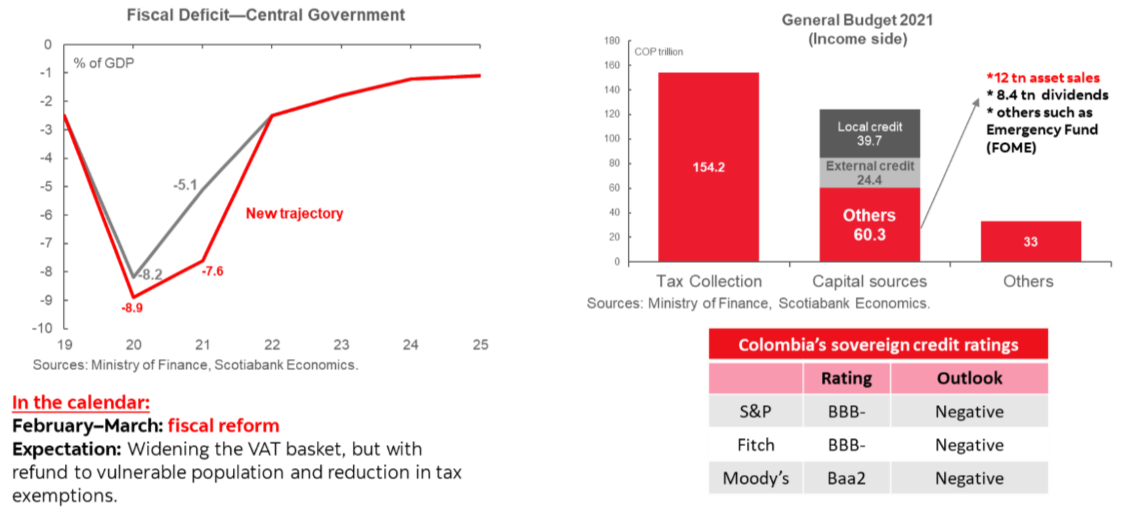Key insights
New COVID-19 outbreaks are not denting our expectations of economic recovery; extraordinary liquidity support should continue.
However, vaccinations have been rolled out more slowly than the virus has spread. Risks to growth will persist and volatility could remain high.
In this environment, EMs’ fiscal space is smaller than usual. Fiscal adjustments will be even more relevant than in normal times.
Central banks will remain on the accommodative side: BanRep shall hold its rates in the coming months, while fiscal policy will be in the spotlight. Tax reform is essential.
In 2020 the economy recovered in line with the re-opening
Some sectors have already recovered 2019 production levels; however, employment hasn’t rebounded at the same pace.

The “new normal” scheme has accelerated the recovery
By the end of 2020, the services-related sector led the recovery, strongly related to the re-opening’s consolidation.
We expect the economy to be more resilient in 2021 since lockdowns are now more targeted and shorter.

The economy should continue its recovery as restrictions ease
At the beginning of the year, Colombia’s main cities implemented targeted restrictions, mainly on activities with intense social interactions. However, as COVID-19 new case numbers came down, restrictions were eased by the end of January.

Deaths and ICU occupation diminished
Reduction in rates of ICU occupation triggered new re-opening measures.

Vaccination program… coming soon
The Colombian government announced that the mass vaccination program would begin on February 20; it is expected that a total of 35 million people will be covered by it this year.

Leading indicators pointed to resilient activity in January
Energy demand was close to the previous year’s levels, while gasoline demand reductions were moderate.

Consumption was the sector hardest hit by the lockdowns
However, in February, Scotia Colpatria transactions rebounded as soon as the main cities eased restrictions.

The consumption basket is normalizing
Non-essential purchases are gaining traction.

Employment recovery matters, but also its quality
After re-opening announced in August, job recoveries were substantial. Now, employment gains are moderating. However, informality is increasing, as it is the most flexible path for people to earn money.

A long road to go before we reach pre-pandemic production levels
In 2020, the economy ended close to 2018 production levels, with the output gap narrowing gradually.

Inflation should rebound as “new normal” consolidates
Some CPI groups remain weak on the back of negative demand pressures. However, in 2021 all the atypical effects, such as subsidies and education-fee reductions, should vanish, and CPI inflation should converge toward the 3% y/y target after the second quarter.

Monetary policy should remain on the sidelines
Despite the dovish call from the BanRep’s staff, the Board is expected to maintain the monetary-policy rate at 1.75% in the coming months until hard data confirms the economic recovery and gives a better sense of the output gap. Even though inflation should remain low in the near term, its expected rebound this year should prevent the Board from cutting.

Fiscal policy: looking for medium-term sustainability
Although the sale of ISA should generate income for the authorities in 2021, its effects will be short-lived. Tax reform continues to be essential. However, the potential to increase revenue collection may be limited.

FX volatility could persist, but ranges should be narrow
Current levels in the USDCOP are above what fundamentals imply; however, fiscal uncertainty and economic recovery could keep the COP weaker than its equilibrium value, at around 3,500–3,550 in the short term.

The yield curve’s slope reflects fiscal uncertainty
Large COLTES issuance and fiscal discussions should keep the yield curve steep, while global risk sentiment could limit directional movements in average rates.

Debt swaps shall continue in 2021
The long end of the curve should continue facing supply pressures.

Portfolio investment flows
Offshore investors were main COLTES buyers in 2020; in 2021, we expect them to maintain their share of local debt.

Macro forecasts

Scotiabank Economics (Colombia)
Sergio Olarte
+57.1.745.6300
Scotiabank Colombia
sergio.olarte@scotiabankcolpatria.com
Jackeline Piraján
+57.1.745.6300
Scotiabank Colombia
jackeline.pirajan@scotiabankcolpatria.com
DISCLAIMERS
Este informe ha sido preparado por Scotiabank Colpatria S.A. establecimiento bancario. Las opiniones, estimados y proyecciones contenidas, corresponden a la fecha de divulgación y se encuentran sujetos a cambios sin previo aviso, pues atienden al comportamiento de la economía y el entorno. Los datos expuestos en el documento provienen de fuentes públicas consideradas fidedignas, sin embargo Scotiabank Colpatria S.A. no se hace responsable de su veracidad ni de la interpretación que de los mismos se haga. Este documento no es ni pretende brindar asesoría de inversión; la información, herramientas y material contenido en el texto, son proporcionados meramente con fines informativos y no deben ser utilizados ni entendidos como una oferta, consejo, asesoría o recomendación de inversión ni para comprar, vender o emitir valores y/o cualquier otro instrumento financiero, ni para realizar cualquier otro tipo de transacción financiera. El contenido de la presente comunicación o mensaje no constituye una recomendación profesional para realizar inversiones en los términos del artículo 2.40.1.1.2 del Decreto 2555 de 2010 o las normas que lo modifiquen, sustituyan o complementen.
This report has been prepared by Scotiabank Economics as a resource for the clients of Scotiabank. Opinions, estimates and projections contained herein are our own as of the date hereof and are subject to change without notice. The information and opinions contained herein have been compiled or arrived at from sources believed reliable but no representation or warranty, express or implied, is made as to their accuracy or completeness. Neither Scotiabank nor any of its officers, directors, partners, employees or affiliates accepts any liability whatsoever for any direct or consequential loss arising from any use of this report or its contents.
These reports are provided to you for informational purposes only. This report is not, and is not constructed as, an offer to sell or solicitation of any offer to buy any financial instrument, nor shall this report be construed as an opinion as to whether you should enter into any swap or trading strategy involving a swap or any other transaction. The information contained in this report is not intended to be, and does not constitute, a recommendation of a swap or trading strategy involving a swap within the meaning of U.S. Commodity Futures Trading Commission Regulation 23.434 and Appendix A thereto. This material is not intended to be individually tailored to your needs or characteristics and should not be viewed as a “call to action” or suggestion that you enter into a swap or trading strategy involving a swap or any other transaction. Scotiabank may engage in transactions in a manner inconsistent with the views discussed this report and may have positions, or be in the process of acquiring or disposing of positions, referred to in this report.
Scotiabank, its affiliates and any of their respective officers, directors and employees may from time to time take positions in currencies, act as managers, co-managers or underwriters of a public offering or act as principals or agents, deal in, own or act as market makers or advisors, brokers or commercial and/or investment bankers in relation to securities or related derivatives. As a result of these actions, Scotiabank may receive remuneration. All Scotiabank products and services are subject to the terms of applicable agreements and local regulations. Officers, directors and employees of Scotiabank and its affiliates may serve as directors of corporations.
Any securities discussed in this report may not be suitable for all investors. Scotiabank recommends that investors independently evaluate any issuer and security discussed in this report, and consult with any advisors they deem necessary prior to making any investment.
This report and all information, opinions and conclusions contained in it are protected by copyright. This information may not be reproduced without the prior express written consent of Scotiabank.
™ Trademark of The Bank of Nova Scotia. Used under license, where applicable.
Scotiabank, together with “Global Banking and Markets”, is a marketing name for the global corporate and investment banking and capital markets businesses of The Bank of Nova Scotia and certain of its affiliates in the countries where they operate, including; Scotiabank Europe plc; Scotiabank (Ireland) Designated Activity Company; Scotiabank Inverlat S.A., Institución de Banca Múltiple, Grupo Financiero Scotiabank Inverlat, Scotia Inverlat Casa de Bolsa, S.A. de C.V., Grupo Financiero Scotiabank Inverlat, Scotia Inverlat Derivados S.A. de C.V. – all members of the Scotiabank group and authorized users of the Scotiabank mark. The Bank of Nova Scotia is incorporated in Canada with limited liability and is authorised and regulated by the Office of the Superintendent of Financial Institutions Canada. The Bank of Nova Scotia is authorized by the UK Prudential Regulation Authority and is subject to regulation by the UK Financial Conduct Authority and limited regulation by the UK Prudential Regulation Authority. Details about the extent of The Bank of Nova Scotia's regulation by the UK Prudential Regulation Authority are available from us on request. Scotiabank Europe plc is authorized by the UK Prudential Regulation Authority and regulated by the UK Financial Conduct Authority and the UK Prudential Regulation Authority.
Scotiabank Inverlat, S.A., Scotia Inverlat Casa de Bolsa, S.A. de C.V, Grupo Financiero Scotiabank Inverlat, and Scotia Inverlat Derivados, S.A. de C.V., are each authorized and regulated by the Mexican financial authorities.
Not all products and services are offered in all jurisdictions. Services described are available in jurisdictions where permitted by law.


